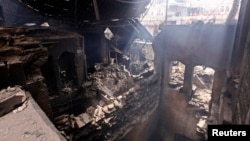Syria is one of the cradles of civilization, a place where humans first learned to live together in towns and cities. The societies that flourished in Syria mastered technologies including farming, pottery-making, metal-working, and glass blowing, creating many beautiful artifacts. From the remains of immense Bronze and Iron Age cities, to extensive Greek and Roman metropolises, breathtaking medieval castles, and masterpieces of art and architecture, Syrians have produced some of the world's most spectacular cultural treasures. Syria is home to six of UNESCO’s World Heritage Sites, and another twelve have been nominated for inclusion.
Three and a half years of conflict in Syria has led not only to a devastating humanitarian crisis in which at least 170,000 people have been killed and millions of people have been displaced within Syria and beyond its borders, but the ensuing chaos and destruction has also led to a devastating impact on the country’s historical landmarks. Many, if not most, including the World Heritage sites, have been damaged or destroyed, while archaeological sites have been ruthlessly and systematically plundered.
The United States strongly supports efforts to preserve Syria’s cultural heritage and continues to call on all parties to the conflict to respect and protect Syrian cultural sites, including museums, archives, and places of archaeological, historic, and religious significance. Last September, the U.S. Department of State and the International Council of Museums created an Emergency Red List of Syrian Cultural Objects at Risk, which alerts law enforcement personnel, art dealers, and collectors to the types of plundered artifacts that may be circulating illegally on the antiquities market.
More recently, in early August, the State Department, and the American Schools of Oriental Research signed a $600,000 cooperative agreement to comprehensively document the current condition of cultural heritage sites in Syria and assess the future restoration, preservation, and protection needs for those sites. We hope to raise global awareness of the threats to Syria’s cultural heritage and identify immediate or future projects and assistance that can be carried out and provided inside Syria.
The United States will continue to closely monitor and raise awareness about threats to the heritage of Syria. We owe this to the Syrian people, who are being stripped of their cultural identity, and to the world at large that respects, admires, and studies this heritage.

















